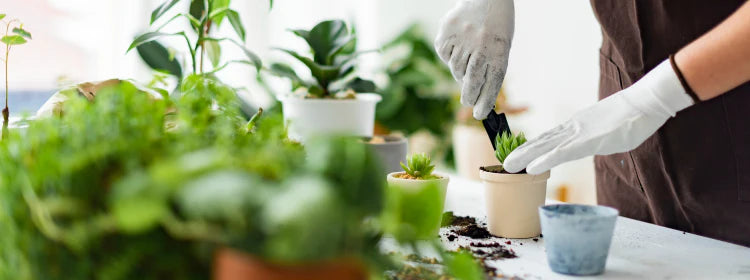There’s a quiet magic in caring for houseplants. We water them, give them food, and turn them toward the sunlight, feeling happy every time a new leaf shows up. But sometimes, that growth can become a bit chaotic. This is where the art of pruning comes in. For many plant lovers, the thought of cutting back their precious greens can feel scary. It feels counterintuitive, even destructive. But in reality, a thoughtful prune is one of the most profound acts of care you can provide. It’s not about stunting your plant; it’s about guiding it toward a future of vigorous health and beautiful form.
Why you Should Prune Your Indoor Plants?
Pruning is not just about aesthetics. It’s an essential part of plant care that encourages stronger growth, prevents disease, and improves air circulation. Just like a haircut helps human hair grow thicker and healthier, removing dead or overgrown parts of a plant allows it to focus its energy on healthy growth. Pruning also prevents your plants from becoming unruly, which can be especially important for indoor spaces with limited room. Neglecting pruning can lead to several issues. Stems may become weak and unable to support leaves or flowers; leaves can become crowded and trap moisture. Regular trimming keeps your plant visually appealing while supporting its health from the roots up.
When to Prune Indoor Plants?
Knowing when to prune is just as important as knowing how. It’s about working with your plant's natural cycle, not against it. Think of it like this: you wouldn't want to undergo major surgery right before running a marathon. Similarly, we want to prune our plants when they are at their strongest and most capable of healing. Some signs that your plant needs pruning include:
-
Yellowing, brown, or wilted leaves
-
Leggy or stretched-out growth
-
Overcrowded stems preventing airflow
-
Dead flowers or seed pods
By observing your plants closely, you can catch these signs early and prevent bigger problems later.
Tools You’ll Need for Pruning:
You don’t need a lot of equipment to start pruning indoor plants, but having the right tools makes the job easier and safer. Basic tools include:
-
Sharp scissors or pruning shears
-
Tweezers or small scissors
-
Gloves
-
Disinfectant
Basic Pruning Techniques:
-
Removing Dead or Dying Leaves:
Start by inspecting your plant for leaves that are yellow, brown, or damaged. These leaves no longer contribute to the plant’s health and can sap energy if left in place. Gently snip them off at the base of the stem or near the node where it joins a healthy stem.
-
Trimming Leggy Growth:
If your plant has stretched-out stems with sparse leaves, it’s time for a trim. Cut back stems just above a leaf node, the point where leaves emerge from the stem. This encourages new growth and helps the plant become bushier rather than tall and thin.
-
Shaping for Aesthetics:
Some plants, like Ficus or Schefflera, respond well to shaping. Identify the natural structure of the plant and prune to create balance and symmetry. For trailing plants like Pothos or Ivy, selective pruning can prevent the plant from tangling or growing too long.
-
Encouraging Branching:
Pinching or cutting back stems on certain plants stimulates branching. This is especially useful for small indoor plants that you want to look fuller. Simply cut or pinch just above a node, and new shoots will emerge from the sides.
-
Deadheading Flowers:
For flowering plants, removing spent blooms encourages the plant to produce more flowers. Cut off the flower stem close to the base, being careful not to damage surrounding leaves.
After care:
After you have pruned your plants, it is best to follow a care routine that will help them grow. Sometimes negligence in after care can harm your plant or even dry it out. First, you shouldn’t water the plant immediately. Fresh cutting and dampened soil can invite fungus or rot. Allow these cuts to dry and to heal themselves. If the soil is already dry, it's okay to water the soil itself, but avoid getting water on the fresh cuts.
Place it back in its familiar spot with bright, indirect light. Avoid direct and harsh sunlight. Avoid fertilizing right away, as the plant needs time to heal and redirect energy to new growth. Water carefully, keeping the soil moist but not waterlogged. Monitoring the plant for any signs of disease or pests is also crucial. Sometimes cuts can be entry points for pathogens, so maintaining clean tools and a healthy environment reduces risk.
Common Pruning Pitfalls to Avoid
1. Using dull or dirty tools
If your scissors are old or dirty, they will crush the stem instead of cutting it cleanly. This makes it harder for the plant to heal. Always use sharp, clean scissors so the plant can recover quickly.
2. Cutting off too much at once
It’s easy to get carried away, but cutting off too many leaves at once can shock the plant. A good rule is to never remove more than one-third of the plant in a single pruning session.
3. Not knowing what your plant needs
Some plants, like succulents, don’t need much pruning. Others, like herbs, grow better when trimmed regularly. Always look up what your specific plant needs before you start cutting.
4. Forgetting to clean your tools
If you use the same scissors on multiple plants without cleaning them, you could spread diseases. Make sure to wipe your tools with rubbing alcohol before switching to another plant.
Conclusion:
Pruning and shaping indoor plants is both a science and an art. It’s about understanding the plant’s growth patterns, responding to its needs, and shaping it in a way that complements your home. Regular maintenance keeps plants healthy, encourages lush growth, and creates a visually appealing indoor garden that feels alive. With the right tools, timing, and techniques, even the simplest indoor plants can transform into striking, vibrant focal points in your home.



